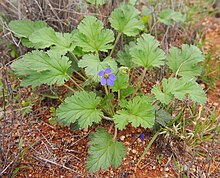Erodium cygnorum
| Erodium cygnorum | |
|---|---|

| |
| Scientific classification | |
| Kingdom: | Plantae |
| Clade: | Tracheophytes |
| Clade: | Angiosperms |
| Clade: | Eudicots |
| Clade: | Rosids |
| Order: | Geraniales |
| Family: | Geraniaceae |
| Genus: | Erodium |
| Species: | E. cygnorum
|
| Binomial name | |
| Erodium cygnorum | |
Erodium cygnorum is a species of herb native to Australia.
It is commonly known as blue heronsbill in Western Australia,[1] and blue storksbill in South Australia.[2] In the United States, where the species is cultivated as a garden plant, it is commonly known as Australian stork's bill[3] and Australian filaree.[4] In the British Isles, it is commonly known as western stork's-bill.[5]
Description
[edit]It grows as an annual or perennial herb up to 60 centimetres high, with blue, purple or pink flowers.[1]
Taxonomy
[edit]This species was published in 1845, based on a specimen collected from the vicinity of Perth, Western Australia by Ludwig Preiss in 1839. In 1958, Roger Charles Carolin published a subspecies, Erodium cygnorum subsp. glandulosum, but this has since been promoted to species rank as E. carolinianum.[6] No infraspecific taxa of E. cygnorum are currently recognised.
Distribution and habitat
[edit]It is native to Australia, occurring in Western Australia, South Australia and the Northern Territory.[7] The National Herbarium of New South Wales lists E. cygnorum as also occurring in New South Wales,[8] but they further identify their specimens as E. cygnorum subsp. glandulosum;[9] that is, E. carolinianum.
It favours red sand or clay loam, occurring in low-lying flats, along creeklines and on the margins of salt lakes.[1]
References
[edit]- ^ a b c "Erodium cygnorum Nees". FloraBase. Western Australian Government Department of Biodiversity, Conservation and Attractions.
- ^ "Erodium cygnorum". Germplasm Resources Information Network. Agricultural Research Service, United States Department of Agriculture., citing Jessop, J. P. & Toelken, H. R. (1986). Flora of South Australia (4th ed.).
- ^ NRCS. "Erodium cygnorum". PLANTS Database. United States Department of Agriculture (USDA). Retrieved 19 January 2016.
- ^ "Erodium cygnorum Nees". CalFlora. Retrieved 2009-01-05.
- ^ BSBI List 2007 (xls). Botanical Society of Britain and Ireland. Archived from the original (xls) on 2015-06-26. Retrieved 2014-10-17.
- ^ "Erodium cygnorum subsp. glandulosum Carolin". Australian Plant Name Index (APNI), IBIS database. Centre for Plant Biodiversity Research, Australian Government.
- ^ "Erodium cygnorum". Germplasm Resources Information Network. Agricultural Research Service, United States Department of Agriculture.
- ^ Nees. "New South Wales Flora Online: Erodium cygnorum". Royal Botanic Gardens & Domain Trust, Sydney, Australia.
- ^ Carolin. "New South Wales Flora Online: Erodium cygnorum subsp. glandulosum". Royal Botanic Gardens & Domain Trust, Sydney, Australia.
